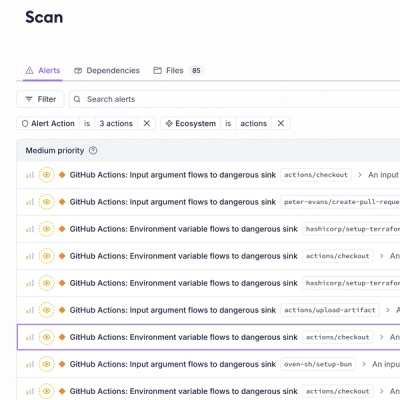
Product
Introducing Socket Firewall Enterprise: Flexible, Configurable Protection for Modern Package Ecosystems
Socket Firewall Enterprise is now available with flexible deployment, configurable policies, and expanded language support.
@ndn/naming-convention2
Advanced tools
This package is part of NDNts, Named Data Networking libraries for the modern web.
This package implements NDN naming conventions based on typed components.
The current format, sometimes known as rev3 format, is specified in NDN-TR-0022 revision 3 and Name Component Type Assignment rev29, published in 2021. It is supported in most other libraries and recommended for new applications.
import { Keyword, Version, Segment, Timestamp, AltUri } from "@ndn/naming-convention2";
// other imports for examples
import { Name } from "@ndn/packet";
import assert from "node:assert/strict";
// convention.create() returns a Component.
let name = new Name(["A", Keyword.create("metadata")]);
assert.equal(name.toString(), "/8=A/32=metadata");
// name.append() has an overload for convention component.
name = name.append(Version, 3);
assert.equal(name.toString(), "/8=A/32=metadata/54=%03");
name = name.append(Segment, 0);
assert.equal(name.toString(), "/8=A/32=metadata/54=%03/50=%00");
// convention.match() checks whether a Component follows the convention.
assert.equal(Segment.match(name.at(-1)), true);
assert.equal(Version.match(name.at(-1)), false);
// Or you can use component.is().
assert.equal(name.at(-1).is(Segment), true);
assert.equal(name.at(-1).is(Version), false);
// convention.parse() extracts the value from a Component.
assert.equal(Keyword.parse(name.at(-3)), "metadata");
assert.equal(Version.parse(name.at(-2)), 3);
assert.equal(Segment.parse(name.at(-1)), 0);
// Or you can use component.as().
assert.equal(name.at(-3).as(Keyword), "metadata");
assert.equal(name.at(-2).as(Version), 3);
assert.equal(name.at(-1).as(Segment), 0);
This package exports AltUri that implements alternate URI syntax for the naming conventions.
Make sure you are importing AltUri from this package, not from @ndn/packet package.
This feature is not in the regular component.toString() and name.toString() methods, because not every application would adopt this particular set of naming conventions.
It is incorrect to interpret "54=%03" as "version 3" everywhere, because in some applications it could mean something completely different.
Using AltUri from this package indicates you have adopted these naming conventions.
// Use AltUri.ofName() and AltUri.ofComponent() to print as alternate URI syntax.
assert.equal(AltUri.ofName(name), "/A/32=metadata/v=3/seg=0");
assert.equal(AltUri.ofComponent(name.at(2)), "v=3");
// Use AltUri.parseName() and AltUri.parseComponent() to parse from alternate URI syntax.
assert(AltUri.parseName("/A/32=metadata/v=3/seg=0").equals(name));
assert(AltUri.parseComponent("v=3").equals(name.at(2)));
Timestamp can be constructed from either number or Date object. The number can be interpreted as either microseconds or milliseconds since Unix epoch. The name component is always encoded as microseconds since Unix epoch per specification.
// Creating from number, interpreted as microseconds since Unix epoch:
const tsA = Timestamp.us.create(819170640000000);
// Creating from number, interpreted as milliseconds since Unix epoch:
const tsB = Timestamp.ms.create(819170640000);
// Creating from Date object:
const tsC = Timestamp.create(new Date("1995-12-17T03:24:00Z"));
// They shall create the same name component:
assert.ok(tsA.equals(tsB));
assert.ok(tsA.equals(tsC));
// Parsing into number as microseconds from Unix epoch:
assert.equal(Timestamp.us.parse(tsB), 819170640000000);
// Parsing into number as milliseconds from Unix epoch:
assert.equal(Timestamp.ms.parse(tsC), 819170640000);
// Call the Date constructor if you want a Date object:
assert.deepEqual(new Date(Timestamp.ms.parse(tsA)), new Date("1995-12-17T03:24:00Z"));
As shown in the examples, you can use .us sub-convention for microseconds unit or use .ms sub-convention for milliseconds unit.
The Timestamp convention is a shorthand for Timestamp.ms.
Number-based conventions, such as Version and Segment, can be constructed from and parsed into either number or bigint.
// Creating from number:
const verA = Version.create(7);
// Creating from bigint:
const verB = Version.create(7n);
// They shall create the same name component:
assert.ok(verA.equals(verB));
// Parsing into number:
assert.equal(Version.parse(verB), 7);
// Parsing into bigint:
assert.equal(Version.big.parse(verB), 7n);
As shown in the examples, you can use .big sub-convention to parse as bigint.
This is supported in Version, Segment, ByteOffset, SequenceNum, and GenericNumber.
However, this is not supported in Timestamp.
GenericNumber is a number-based convention that encodes a GenericNameComponent with NonNegativeInteger as TLV-VALUE. Despite not part of the naming convention specification, it is adopted by several NDN protocols, so that it is included for convenience.
This package also implements rev2 format, as specified in NDN-TR-0022 revision 2 and Name Component Type Assignment rev17, published in 2019.
Import Segment2, ByteOffset2, Version2, Timestamp2, SequenceNum2, AltUri2 to access this format.
You should not use this outdated and obsolete format in new applications, except for accessing old data.
FAQs
NDNts: Naming Convention rev2 and rev3
We found that @ndn/naming-convention2 demonstrated a healthy version release cadence and project activity because the last version was released less than a year ago. It has 0 open source maintainers collaborating on the project.
Did you know?

Socket for GitHub automatically highlights issues in each pull request and monitors the health of all your open source dependencies. Discover the contents of your packages and block harmful activity before you install or update your dependencies.

Product
Socket Firewall Enterprise is now available with flexible deployment, configurable policies, and expanded language support.

Security News
Open source dashboard CNAPulse tracks CVE Numbering Authorities’ publishing activity, highlighting trends and transparency across the CVE ecosystem.

Product
Detect malware, unsafe data flows, and license issues in GitHub Actions with Socket’s new workflow scanning support.